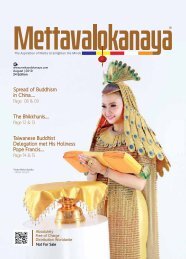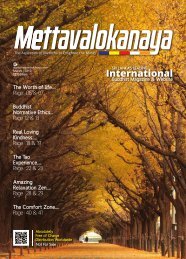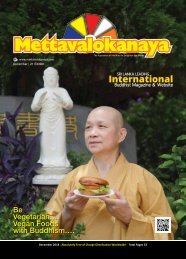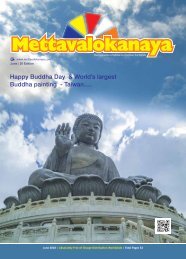#Mettavalokanaya_International_Buddhist_Magazine_May_2021
This is the World’s Most Popular & Leading Monthly International Buddhist Magazine, “Mettavalokanaya” on May 2021 Vesak Edition - 31. https://mettavalokanaya.com/magazine-31/ http://www.mettavalokanaya.com/
This is the World’s Most Popular & Leading Monthly International Buddhist Magazine, “Mettavalokanaya” on May 2021 Vesak Edition - 31.
https://mettavalokanaya.com/magazine-31/
http://www.mettavalokanaya.com/
You also want an ePaper? Increase the reach of your titles
YUMPU automatically turns print PDFs into web optimized ePapers that Google loves.
The Inversion...
To invert is to put something
upside down. Are human
beings prone to inversion?
What is the inversion that
human beings are prone to have?
“Marvelous, venerable sir! Marvelous,
venerable sir! As if, venerable sir, a
person was to turn face upward what
is upside down, or to uncover what
was concealed, or to point the way
to one who is lost or to carry a lamp
in the darkness, thinking, ‘Those who
have eyes will see visible objects,’ so
has the Dhamma been set forth in
many ways by the Blessed One. We,
venerable sir, go to the Blessed One
for refuge, to the Dhamma for refuge,
and to the Community of Bhikkus for
refuge. Venerable sir, may the Blessed
One regard us as lay followers who
have gone for refuge for life, from
today.” (Kalama Sutta)
What is inverted? Those that
are inverted are the six faculties of
eye, ear, nose, tongue, body and mind.
Once the faculties get inverted, they
become agencies (Aayathana). The
Aayathana shrouded by delusion with
make things that are of attachment
or lust or of hate. So we create our
world of the six touch-agencies. In
the Hemawatha Sutta Buddha told
Sathagiri and Hemawatha,
Of six is world formed, with six
it associates, having grasped with the
six, will lament with the six. When
devout people listen to the Dhamma
expounded by Buddha, they begin to
find the realization of the truth. In
such people, development of the five
faculties of Saddha or faith, Viriya
or striving, Sathi or mindfulness,
Samadhi or concentration and Panna
or wisdom begins to develop. Then the
five Indriya of eye, ear, nose, tongue
and body begin to turn upwards, and
no longer they are now agencies
(Aayathana) shrouded by lust and
hate. Now they are steeped in virtue
and will not break any of the factors
of virtue even if one is on the verge of
losing one’s life.
From now onwards they will be
following the path shown by Buddha,
“Sabba papassa akaranan, Kusalassa
Upasampada. Sachiththa pariyo
dapanan, ethan Buddhanusasanan”
Steeped in virtue, develop mindfulness
and concentration with Meditation.
Understanding the nature of mind
with Vipassana and tame it. This is the
teaching of all Buddha.
Meditation - How does a
meditative yogi realize this change
from agency to faculty? In breathing
meditation (Anapana Sathi) yogi will
initially discern the breath as long
or as short as the case may be. This
discernment is still in the agency
situation. Then the yogi will move
on to next stage of feeling the whole
body. What is the whole body in
meditation?
Often it is explained as
beginning, middle and end of each
in and out breath. But in Sabba
Sutta Buddha told Bhikkus about
all, and of body it is the body and
tactile sensations in the body which
together leads body consciousness
to contact and to feelings. The yogi
in this body will have happy feelings,
unhappy feelings or neutral feelings
at the same time which the yogi will
observe scanning the body from top
to bottom and bottom to top.
This is seeing as it is and not as
per the conventions, the beginning
of Vipassana. It is here the agencies
of the yogi will turn up and the
development of faculties of Saddha,
Viriya, Sathi, Samadhi and Panna
begin. Offering flowers, lighting oil
lamps, burning incense sticks and
many other offering are good as
those will be a starting point for the
children and youth to develop faith in
Buddha, Dhamma and Sangha. But just
doing ceremonial things only and not
getting on to the path that Buddha
showed us to take will not enable us
to realize the truth of Nirvana in this
life.
In the Pabhassara Sutta
(Anguththara Nikaya), Buddha said
“Luminous, monks, is the mind. It is
defiled by incoming defilements. The
person who has not heard Dhamma
and thus is uninstructed doesn’t
discern that as it actually is present,
which is why I tell you that for the
uninstructed person there is no
development of the mind.” “Luminous,
monks, is the mind. And it is freed
from incoming defilements. The wellinstructed
disciple who had heard
Dhamma of the noble ones discerns
that as it actually is present, which is
why I tell you that for the instructed
disciple of the noble ones there is
development of the mind.”
“Develop
Mindfulness &
Meditation”
Sugath Rajapakse
Formerly Senior Commercial
Manager at Sri Lankan Airlines and
presently Consultant to Air India GSA
in Sri Lanka.
52 l Mettavalokanaya l May l 2021 2021 l May l Mettavalokanaya l 53
















